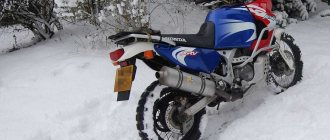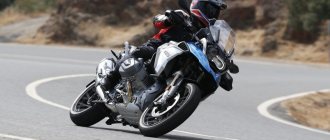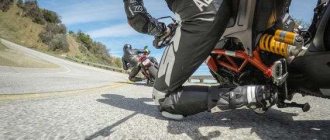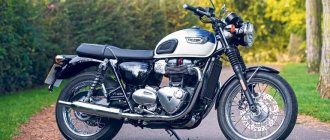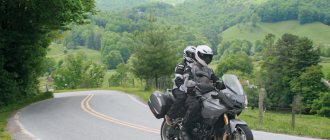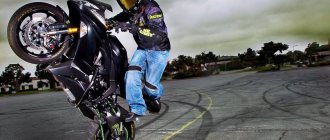Good afternoon, dear reader.
This article will discuss the rules of the road for motorcycle drivers.
I would like to note right away that, in general, the rules for motorcyclists are not very different from the rules for passenger cars, so only their main differences will be discussed below.
Let me remind you that earlier on “Traffic Rules Master” the rules for bicycles and mopeds were discussed.
What vehicles are classified as motorcycles?
First of all, let's look at paragraph 1.2 of the traffic rules, which defines the concept of a motorcycle:
“Motorcycle” is a two-wheeled motor vehicle with or without a side trailer, the engine displacement of which (in the case of an internal combustion engine) exceeds 50 cc. cm or the maximum design speed (with any engine) exceeds 50 km/h. Motorcycles are considered tricycles, as well as quadricycles with a motorcycle seat or motorcycle-type handlebars, having an unloaded weight not exceeding 400 kg (550 kg for vehicles intended for the transport of goods), excluding the weight of batteries (in the case of electric vehicles), and the maximum effective engine power not exceeding 15 kW.
So, motorcycles include two-wheeled vehicles that have one of the following characteristics:
- The maximum speed exceeds 50 km/h.
- Engine volume exceeds 50 cm3.
Note. A vehicle whose maximum speed is less than 50 km/h and whose engine capacity does not exceed 50 cm3 is a moped from the point of view of traffic regulations.
In addition, motorcycles include three-wheeled and four-wheeled vehicles that:
- They have a motorcycle seat or motorcycle-type handlebars.
- Have an unladen weight of 400 kg or less (550 kg for commercial vehicles) excluding battery weight. This value is indicated in the “Weight without load, kq” field on the back of the registration certificate.
- Have a maximum effective motor power of 15 kW or less.
What should number two know?
The passenger is an important part of the link, on whose behavior the result of the joint journey depends. He needs:
- climb onto the seat after the driver’s permission, holding on to it;
- position yourself as close as possible;
- press your knees to the motorcycle, do not lower your legs;
- when moving, do not distract the driver without unnecessary reason;
- if necessary, use the established signals;
- take into account acceleration and braking so as not to hit your head on the rider’s helmet.
If you follow the recommendations on both sides, the trip will be safe and give you a lot of pleasure. If it's not disposable, it's worth considering some good motorcycle gear. Then you can even go on a long journey.
Driver's license for a motorcycle
To drive a motorcycle, a driver's license of one of the following categories is suitable:
- A1 - only for motorcycles with engine capacity up to 125 cm3 and power up to 11 kW inclusive.
- A - for any motorcycles.
Categories and subcategories of driver's licenses
However, the traffic rules for motorcycles of subcategory A1 and category A do not differ.
Pilot's instructions
The driver is the responsible person who determines how comfortable the trip will be for two. The health and lives of both are in his power. You must be able to maintain balance with the load, which requires special skill. Otherwise, there may be falls on the spot or while moving. Therefore, even if you are a strong single rider, you should practice riding together.
The best option is to take a biker friend with you and run it first off busy roads. He will suggest incorrect manipulations. After adjustments, you can go into the seething expanses of city streets without giving too much gas, constantly balancing. If the run-in goes well, feel free to offer a ride to others.
The rider should be warned that the motorcycle passenger’s clothing meets the requirements: thick trousers, jacket, gloves, glasses. You need boots that cover the ankle. Such equipment is selected regardless of the weather. Even if it’s warm outside, a speeding bike will cause a lot of trouble in its absence (at least a piercing wind). If a fall occurs, clothing can protect the body. To prevent damage to your bike, use motorcycle protection.
You need to tune in for trouble-free driving and feel confident. Otherwise, it’s better not to leave. If the passenger footrests were hidden, they should be bolted down. Make it clear that the legs are placed on them (exhaust pipes are excluded). It is important to remember that you should sit on the motorcycle with the side stand raised. After this, the transmission does not engage until the rider is seated.
You need to establish contact with him before the motorbike starts moving. Explain how to behave while moving: don’t twitch, don’t be afraid, try to follow your movements and repeat them, especially when turning. Develop conditioned signals such as: tap on the shoulder - slow down please, tap on the knee - stop.
Pedestrian driving a motorcycle
“Pedestrian” is a person who is outside a vehicle on the road or on a pedestrian or bicycle path and is not working on them. Persons moving in wheelchairs, driving a bicycle, moped, motorcycle, carrying a sled, cart, baby or wheelchair, as well as using roller skates, scooters and other similar means for movement are considered pedestrians.
A motorcycle driver, like cyclists and mopedists, can become a pedestrian at any time. To do this, he just needs to get off the motorcycle and drive the motorcycle next to him.
Motorcyclists can use this technique for their convenience:
For example, a motorcycle is driving along a country road that has a dividing strip. He wants to turn left (to the village), but turning left is impossible because a median fence runs through the intersection. Therefore, the motorcyclist is forced to drive straight and turn around after a few kilometers along a special turning loop.
However, there is another option - to dismount and cross the road at a pedestrian crossing, which is located next to a public transport stop.
In addition, you need to remember that a pedestrian driving a motorcycle on the roadway must move along the flow of vehicles, i.e. on the right side of the road. Paragraph 4.1 of the traffic rules:
When walking along the edge of the roadway, pedestrians must walk towards the movement of vehicles. Persons moving in wheelchairs, driving a motorcycle, moped, bicycle, in these cases must follow the direction of travel of the vehicles.
Road rules for motorcyclists
This article is a collection of tips for novice motorcyclists. These tips are not combined by topic or group; they are written down in a row from the words of motorcyclists with extensive piloting experience, edited and supplemented by professional motorcycle school instructors.
- You should not drive behind a cargo vehicle - stones fly out from under the uncovered wheels at high speed and to a considerable height. If such a “projectile” hits a motorcycle, it can damage the paintwork, and if it hits the pilot, it can result in bruises and soft tissue injuries. If the motorcyclist is not wearing protective equipment, getting hit by such a stone in the body or head can easily lead to loss of control and, consequently, a fall.
- Never try to run away from traffic police officers, especially from a motorcycle battalion. As practice shows, in 90% of cases the offender is caught or he himself gets into an accident during the chase. You should also not get involved in street racing on motorcycles or try to compete with someone on public roads, the risk of getting into an accident is too great. If you want to compete, go to a specially equipped motorcycle track. As a rule, there are such tracks in every big city.
- The main cause of most fatal motorcycle accidents is alcohol. According to statistics, about 50% of motorcyclists who died in road accidents drank alcohol. Moreover, even a small amount of alcohol consumed can critically slow down the reaction of a motorcycle pilot.
- When purchasing a chain-driven motorcycle, immediately purchase chain lube. Don’t skimp on it, the lubricant should stick well and preferably have a color so that you can accurately determine the degree of coverage. The chain needs to be lubricated every 500 km and after every trip in the rain (washing). With this care, a chain with stars can last a very long time.
- After purchasing a motorcycle, immediately take care of its safety - a standard steering lock is quite easy to break. It is worth purchasing a disc lock with an alarm and a GPS beacon to track the location of the motorcycle.
- Keep in mind one feature when braking with the front brake on a motorcycle - the lower the speed, the greater the likelihood of the front wheel locking if the force on the front brake lever is inaccurately applied. This is another argument in favor of why you should not try to brake at low speeds with only the front brake - it should not account for more than 75% of the total braking force. Almost always, when driven inappropriately, the motorcycle falls to one side if the front wheel locks. Remember also that during hard braking, weight tends to shift forward, and the rear wheel is largely unloaded, and it will tend to lock much faster, so after sharply pressing the rear brake pedal, be ready to release it in time. In modern traffic conditions and at current speeds, the proportion of braking force is closer to 65% front and 35% rear, while braking at high speeds should be as intermittent as possible.
- If possible, never be in the blind spot of other drivers. Speed up or slow down. Don't let anyone be in your blind spot.
- You should not ride your motorcycle again after 8 pm, especially on Friday and Saturday. There are several reasons for this: - there are more drunk people on the roads - the possibility of animals appearing on country roads increases - at night the amount of visual information received is greatly reduced - for natural reasons, due to fatigue, the reaction slows down
- When parking on a slope, the front wheel should face the hill, since when starting to move it will be easier to roll the motorcycle back than to push it up the hill. It would also be appropriate to put the motorcycle in gear.
- Braking in a corner always straightens the trajectory. When turning, try to keep the gas steady, and ideally, smoothly open the gas from the beginning to the very end of the turn.
- If you have to stop in a turn, straighten the steering wheel a second before stopping, this will direct the inertial force straight and the front suspension will be able to absorb it evenly. Otherwise, the inertial force directed towards the turn will overwhelm the motorcycle during a sudden stop.
- Earplugs (the kind worn by construction workers or given to passengers when flying helicopters) reduce fatigue during long rides, but greatly reduce the flow of sound information, which is very important when piloting in the city.
- When tying luggage with elastic straps, try to thread them THROUGH the luggage, and do not throw it on top, this will greatly improve the securing of the cargo.
- If you have to travel in very hot weather, a bandana or neckerchief soaked in water can help.
- Enter the turn in a wide arc, this increases the field of view during the turn - this is very significant!
- It is advisable to have special reflective fragments on the back of the equipment. They will allow drivers behind you to correctly assess the distance to you.
- Look only where you want to go; when turning, focus on the exit point with your eyes. If you feel that a fall is inevitable, still continue to look at the area of the road in which you would like to be. Never focus on obstacles, track them with your peripheral vision.
- Before the inevitable holes, bumps and other obstacles, stand on the footrests. By absorbing the impact with your legs, you will reduce the load on the suspension and protect yourself from possible injuries. Try to pass linear obstacles (railroad crossings, speed bumps, etc.) at right angles with slight acceleration to unload the front suspension.
- When parking, make sure that the support (step) is on a solid surface. Keep in mind that asphalt can also be a poor surface for installing a support in hot weather or if it has been exposed to fuel and lubricants. If it is not possible to park the motorcycle on a hard surface, place any solid object under the support that increases the pressure area to at least 10 cm2.
- Take care of your battery and check its condition regularly. If possible, carry out a complete recharging process 2-3 times a season. If the battery is serviceable, check the electrolyte level in the cells and top up if necessary. When parking for long periods, remove the battery and store it in a warm, dry room. The battery can last more than 7 years with proper maintenance.
- If possible, replace the standard sound signal with a more powerful one; for a motorcyclist, this is one of the main devices for attracting the attention of inattentive drivers behind the wheel.
- Develop the habit of keeping 2 fingers on the front brake and clutch levers at all times! Moving your fingers from the handle to the brake lever takes approximately 0.1 seconds, which is almost 3 meters of the motorcycle’s braking distance.
- Take driving courses to improve your driving skills and acquire new skills and knowledge.
- Never skimp on protective equipment. A helmet, a motorcycle jacket (turtle), gloves, motorcycle boots, knee protection - this is the minimum you should wear when driving a motorcycle.
- It is worth taking a first aid course or at least studying the relevant literature.
- At the very beginning of the season, when driving on public roads during daylight hours, always turn on your high beam headlights. This can save you from distracted drivers who have become unaccustomed to the presence of motorcyclists on the roads over the winter.
- Constantly analyze and predict the traffic situation around you. Pay attention to the behavior and actions of drivers behind the wheel of cars.
- Maintain a large distance from the car in front, always leave a reserve for unexpected maneuvers.
- When driving behind cars, try to stay closer to the edge of the median strips, this way you will provide yourself with a larger maneuver area in case of sudden braking of the car in front. Also, this position of the motorcyclist in the traffic makes him more visible in the rear-view mirrors of the vehicle in front.
- Safe driving speed in dense traffic along the row spacing is not exceeding the speed of the surrounding traffic by 20 km/h. Those. when the cars are stopped, your speed should not exceed 20 km/h, but if the traffic moves at a speed of 15 km/h, your speed should not exceed 35 km/h. If this limit is exceeded (20 km/h), the risk of getting into an accident increases by more than 50%. If you follow this rule, you will always have time to react to a door unexpectedly opened by the driver, or a sudden change of lane of the car in front without the turn indicators on.
- Never overtake cars on the right or on the side of the road! This is prohibited by traffic regulations, so many drivers will not even think to look in the right mirror when turning right or parking on the side of the road.
- Always expect inappropriate actions and maneuvers from all drivers around you on the road. The motorcycle saddle is not a place for relaxation and rest, only attentiveness and utmost concentration.
- Always fasten your helmet! Even if you forgot to do it, don’t be lazy to stop and fasten it.
- You should not be the first to leave the intersection when the traffic light turns green. Since many car and motorbike enthusiasts like to fly through intersections on yellow or early red signals, you run the risk of meeting them.
- On slippery sections of the road (markings, rails, hatches), between rows, on steep slopes, during active maneuvering at low speed - try to use only the rear brake.
- Never drive to the left of the left or to the right of the right lane, and especially on a double continuous lane.
- When driving in a traffic jam along the aisle, remember that at any moment a pedestrian crossing the road can jump out from behind a car. 90% of pedestrians cannot even imagine that a motorcyclist might be moving between the rows, so they force traffic jams, not paying attention to the row spacing. This danger increases sharply on narrow streets.
- When changing lanes in a dense stream of cars, pay special attention to the aisle behind you; a motorcyclist like you may be moving there at a speed much higher than the general speed limit.
- For novice motorcyclists, it is best to start the season with an average daily air temperature of more than 10 degrees, and end, accordingly, with a temperature of less than 10 degrees.
- Always, before taking a passenger on your motorcycle, provide at least minimal instruction. A passenger sitting on a motorcycle must hold onto the pilot with his feet and rest his hands on the tank of the motorcycle. You can learn all the secrets of driving a motorcycle with a passenger at a motorcycle school.
Many of the above tips are advisory in nature and it is worth clarifying that when piloting a motorcycle in an urban environment, the pilot often has only a split second to decide on a particular action. Therefore, motorcycle school instructors strongly recommend that beginners and experienced motorcyclists regularly practice their driving skills and actions in extreme situations on specially equipped tracks and sites. Good luck on the road, dear friends!
Is a helmet required on a motorcycle?
The issue of using a helmet on a motorcycle is regulated by clauses 2.1 and 5.1 of the traffic rules:
2.1. The driver of a motor vehicle is obliged to: ... 2.1.2. When driving a vehicle equipped with seat belts, be fastened and do not carry passengers who are not wearing seat belts. When driving a motorcycle, wear a fastened motorcycle helmet and do not carry passengers without a fastened motorcycle helmet.
5.1. Passengers are obliged to:
- when traveling in a vehicle equipped with seat belts, be wearing them, and when riding a motorcycle, wear a fastened motorcycle helmet;
That is, when riding a motorcycle, a helmet must be worn by both the driver and passengers.
Including passengers traveling in a stroller (cradle).
Between rows and faster than others - why is it safer to ride a motorcycle this way?
Speed
Popular biker wisdom says that the number of idiots who want to kill you on the road is directly proportional to speed.
That is, the slower you go, the fewer acute moments. People just have time to notice you. However, this does not mean that “the slower the better.” Moving at a speed lower than the entire flow is also dangerous. In this case, the motorcycle interferes with the movement of other vehicles and becomes, in fact, a stationary object (relative to other vehicles) that they have to go around. However, this situation does not arise often. Is it worth advising not to ride really slow two-wheelers, like mopeds and fifty-kopeck scooters, onto high-speed highways, and not only those marked with green signs, but also “fast roads” in general, like the Third Ring Road in Moscow or WHSD in St. Petersburg.
Driving at excessively high speeds in traffic is also dangerous. Car drivers actually think in different time frames. They don't expect a motorcycle to appear out of nowhere, covering several hundred meters in a couple of seconds. He may have seen the headlight in the mirror when he looked into it before changing lanes, but he was based on the average speed of the traffic. He expected the bike to appear nearby in ten seconds, not three. De jure, such an accident is the fault of the driver of the car, who was not convinced of the safety of the maneuver and did not let the vehicle move in the same direction without changing lanes, but in fact, the driver of the motorcycle is to blame. And it will hurt him, not the motorist.
Driving at the speed of traffic also cannot be called optimal, since a small motorcycle becomes “invisible” against the background of other vehicles. The situation is approximately the same as with a hare in a field. While the hare is sitting, even in an open field without a single bush, it is very difficult to notice. But as soon as he ran, he immediately became visible. A motorcycle moving at the speed of the flow is a hare frozen in an open field.
The optimal speed of a motorcycle in traffic is “plus twenty” kilometers per hour. This speed advantage is considered optimal. The motorcycle becomes visible to all participants in the movement, but does not move too quickly - it is seen and expected. The motorcyclist has the opportunity to take advantage of not only speed, but also the maneuverability of his vehicle.
To understand how a motorcyclist feels among cars, imagine yourself driving a car among trucks. The difference in dynamics and maneuverability will be the same.
Parking the motorcycle
Paragraph 12.2 of the traffic rules:
Parking on the edge of the sidewalk bordering the roadway is permitted only for cars, motorcycles, mopeds and bicycles in places marked with sign 6.4 with one of the signs 8.4.7, 8.6.2, 8.6.3, 8.6.6 - 8.6.9.
Just like cars, motorcycles can be parked in a sidewalk parking lot if there is a sign 6.4 with one of the following plates:
Preparing a motorcycle for a trip with a passenger
Riding with a passenger places an increased load on all parts of the motorcycle, so even if there are minor problems in the technical condition of the bike, you should avoid riding until they are completely eliminated. If a two-wheeled car copes well with the weight of one person, then in order to successfully transport people in the back seat you will need to make the following adjustments:
- Increase tire pressure.
- Adjust the shock absorbers to take into account the increased load.
All of the above manipulations must be carried out according to the original instructions for the specific motorcycle model.
Transporting passengers on a motorcycle
22.21. Transportation of people on a motorcycle must be carried out by a driver who has a driver’s license for the right to drive vehicles of category “A” or subcategory “A1” for 2 or more years; transportation of people on a moped must be carried out by a driver who has a driver’s license for the right to drive vehicles of any category or subcategories for 2 or more years.
Only a driver who has 2 years or more of experience in category A or subcategory A1 can carry passengers on a motorcycle.
Note. This fact has nothing to do with the fact that the driver is a beginner.
For example, a driver has had a category B driving license for 20 years, that is, from the point of view of traffic rules, he is not a beginner. However, he recently received a motorcycle license, so he cannot carry passengers.
22.8. It is prohibited to transport people:
- outside the cabin of a car (except for cases of transportation of people in the back of a truck with a flatbed or in a van), tractor, other self-propelled vehicles, on a cargo trailer, in a caravan trailer, in the back of a cargo motorcycle and outside the seating areas provided for by the design of the motorcycle;
In addition, passengers are prohibited from being transported outside the designated areas.
For example, you cannot put a passenger on the trunk.
Tips for motorcyclists
*Adjust the motorcycle's rear suspension to accommodate the additional load (see your motorcycle manual).
*Always ensure that the passenger has suitable clothing. We are talking about the basics, the minimum: boots, long trousers, a jacket or sweatshirt (they should not be loose or bulky), gloves, of course, a helmet. If you have extra knee and elbow pads, add them to your backpack.
* Make the passenger become familiar with the motorcycle: where to put their feet, what to hold on to. Remember that you know your motorcycle as you know it, but to an outsider it is a mess of cables and metal. Explain that breathing deeply while riding and spreading your arms from side to side is not a good idea - seriously, it's worth mentioning.
* The clutch problem is a priority for obvious reasons. You don't want to lose your passenger, do you? Will the passenger put his arm around your waist, or hold on to the rear handle of the motorcycle? You must explain this before traveling. And forget about the leather strap that some motorcycle daybeds have - it's just a stylish addition, you can't trust it with anyone's safety.
* If this is the “backpack”’s first ride on a motorcycle, make sure he understands two simple things: only you put your feet down during forced stops (traffic lights, stops). The passenger's feet must be on the footrests at all times. Horny "motorcycle virgins" sometimes do things that can get them into trouble.
* Develop a simple communication system regarding the need to stop and other situations such as slowing down or speeding up. There are many combinations and at the same time using sign language is fun.
* Anticipate and think. Your motorcycle will behave differently. Control may be more complex, the overall weight changes, the center of gravity shifts. It's like riding a different motorcycle. When you get on a new car, you don't unscrew the levers and fly around like crazy, right? Also note that braking performance will be reduced. Just be careful.
* While basic advice is easy to give, no one can teach you how to ride with a passenger in a few sentences. It's a matter of practice: accelerating, decelerating, braking, cornering. The passenger must be able to maintain a neutral position.
* Considering your experience and passenger needs, plan your stops in advance. You should establish that you will stop after a quarter or half an hour, this will allow your small team to breathe, relax and feel like moving on. In addition, if you see that the "backpack" is gray, like moon dust, you already know that the next stop should be earlier. Therefore, stops are also used to assess the passenger's condition, drink water and catch their breath.
* Finally, one piece of advice from personal experience. If intimacy allows, show the passenger your approval. It's a light pat on the thigh and maybe a quick thumbs up.
Motorcycle towing
20.4. Towing is prohibited: ...
- two-wheeled motorcycles without a side trailer, as well as such motorcycles;
Towing involving two-wheeled motorcycles is prohibited by law.
However, it is not prohibited to tow motorcycles with a side trailer (cradle), three-wheeled and four-wheeled motorcycles:
Rules for towing vehicles
Fundamental principles on how to learn to ride a bike
There are a large number of novice motorcyclists in the world who are just learning how to control motorcycles.
The following principles have been developed for them on how to learn to ride a bike:
- Driving must be careful. It’s not tedious to try to gain high speeds at the very beginning of your motorcycle riding training.
Important: you need to adequately assess your abilities and choose the driving method that suits your driving level.
- To learn or practice riding a motorcycle, you must choose routes where traffic is not busy.
- watch what happens while driving from behind.
- Choose a low speed for yourself.
- master the skills of anticipating the occurrence of extreme situations on the roads, in which the main thing is not to get confused, but to act according to all the rules.
- When driving, you must only move on a certain side of the roadway. Try to avoid driving in areas where, after a turn, you enter a road with a solid line.
- Try to drive at a certain distance from other road users. The distance between the motorcycle and the vehicle in front of it must be maintained.
- Avoid overtaking and other types of traffic changes.
"Beginner Driver" sign on a motorcycle
In 2022, a driver who has less than 2 years of total experience is required to display a novice driver sign on the rear of the vehicle. does not apply to motorcyclists :
“Beginner driver” - in the form of a yellow square (side 150 mm) with an image of a black exclamation mark 110 mm high - behind motor vehicles (except for tractors, self-propelled vehicles, motorcycles and mopeds) driven by drivers who have the right to drive the specified vehicles less than 2 years old.
Traffic rules for novice drivers
Safety Tips
Responsibility for safe movement on a bike rests entirely with the pilot, therefore, regardless of the experience of driving a two-wheeled vehicle with an additional load, the driver must adhere to the following rules:
- Before boarding a passenger, you must remove the motorcycle from the center stand, sit on it and carefully rest your feet on the ground.
- When boarding a passenger, the front brake must be applied. Even on level ground, the motorcycle can move forward or backward under the influence of increased load. When starting on an ascent or descent, this recommendation will be especially relevant.
- If the passenger has not previously ridden a motorcycle, then even if there are handrails, he should only hold on to the driver.
- The driver is recommended to change gears very smoothly and not to make sudden maneuvers or accelerations.
- Before riding, unfold the footpegs and instruct the passenger to use them only to support their feet when the motorcycle is moving and when stopping. It is strictly forbidden to use an exhaust pipe muffler for these purposes or to place feet on suspension elements or parts of the power unit.
- When carrying a passenger on the back seat of a motorcycle, you should remember that with a larger load, a two-wheeled vehicle will take longer to gain speed, and a significant braking distance will be required to completely stop the bike. For this reason, you should only overtake other vehicles if you are absolutely sure that you have enough time to complete the maneuver.
- Before the trip, the passenger and driver of the motorcycle should pay great attention to their equipment. Be sure to wear a helmet, gloves, thick jacket and trousers. In cold weather, the clothing of the biker and his passengers must be appropriate for the season.
If the driver has not previously driven a motorcycle with an additional load, then he should first practice in a closed area. The ideal option would be to hire a person who knows how to drive a two-wheeler as a passenger. On a flat surface, you should practice all types of movements that may occur in a real situation. It is imperative to perform sharp braking and acceleration, as well as turns at the smallest possible radius and at an extremely low speed.
If a girl drives a motorcycle, she may not be able to cope with the increased load, especially when carrying a massive passenger.

